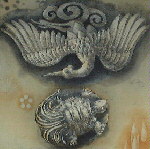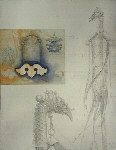![]()
![]()
![]()
![]()
![]()
![]()
Search | Order
| What's New
|
|
Etchings from Angkor, Cambodia and Nara, Japan
Recent Works by Jörg Schmeisser |
 Turtle and Crane © 1998 Jörg Schmeisser
|
Exhibit at The Williams Gallery8 Chambers Street, Princeton NJ
|
 Yakushiji Bell and Banner © 1998 Jörg Schmeisser
|
About the Exhibit
A traveling exhibit with works selected from a recent showing at the Canberra Museum and
Gallery, Australia will be on display at The Williams Gallery Of Princeton beginning on
April 29, 2000. Similar shows are planned for Angkor, Tokyo, Washington DC, Saint Louis,
San Francisco and Gdansk. The artist, Jörg Schmeisser, will be present on Saturday, 29th
April, 5 - 7 PM to discuss his most recent travels and etchings.
Born in Stolp, Pomerania in 1942, Schmeisser attended art school in Hamburg, Germany, and took his post-graduate work at the Fine Arts University of Kyoto, Japan. He moved to Canberra, Australia in 1978 to head the Printmaking Workshop of the Australian National University, Canberra School of Art. His work has been shown in more than 130 solo exhibitions world-wide and is represented in major private and public collections such as the Princeton University Graphic Arts Collection; the Museum of Modern Art, New York; National Gallery of Australia; Bibliotheque Nationale, Paris and the Kunsthalle, Hamburg.
Jörg Schmeisser’s etchings, often done ‘in situ’, display a reverence for the forms and intricacies of nature and culture married to an unrivaled technical prowess. Many of the images demonstrate the artist’s fascination with landscape and architecture, while other portray with great accuracy objects observed in nature. His prints often include descriptive text, usually in German, which becomes an integral part of the composition. A favorite Greek poem of the artist, titled "Ithaka" provides a clue to his lifelong intent:
When you set out for Ithaka
ask that your way be long,
full of adventure, full of instruction
rich with all you have gained on the way
not expecting Ithaka to give you wealth
Ithaka gave you a splendid journey..
The following briefs about the artist and his work are taken, in part, from the 1999 catalogue from the Canberra Museum.
From the onset of his career Schmeisser has been inspired by travel, his imagination fired by regular injections of the unfamiliar and unknown. The stimulation of travel is not novel in the history of printmaking. Artists have gone abroad for a variety of reasons,…Schmeisser’s first extensive travel was to the Middle East in 1965 as part of an excavation team in Israel for the University of Missouri. His objective recording of archaeological finds let to a precision and detail characteristic of much of his later work. Travel to Greece, and return trips to Israel were later followed by journeys through Italy, Australia, India, China, and Japan, and most recently to Angkorand Antarctica. Since making his home in Canberra, Australia, twenty years ago, travel has continued as an integral source of inspiration. As with Durer, his noble German forbear, he has traveled to learn from other cultures and to interact with other artists. As with Whistler, he has captured a new vision of places familiar and unknown, pushing his media to new expressive possibilities.
About Angkor:
Schmeisser has traveled twice to the ruined temples of Angkor. In 1969, he recalls hearing
the bombing in nearby Vietnam, and the optimism of the Cambodians that war would not reach
them. His return in January 1999 was sobering. Where in the past the ruins were studied as
fragments from antiquity, as he had recorded archeological sites in the Middle East, they
now seemed also mute witness to atrocities….
Together with photographer Jaroslav Poncar (with whom he had worked on a project in Ladakh in 1984) Schmeisser records a country’s effort to endure, and even in time of extreme hardship, to affirm the value of the past, the dignity and humanity represented in their cultural heritage, and the simple yet profound conviction that "This is worth keeping". Schmeisser’s Angkor prints, some made directly onto the plates on site, others worked more extensively on his return to his studio from sketches, capture the loss of innocence, and tread the moonlit path between beauty and horror.
About Nara:
Schmeisser has fostered an ongoing relationship between Canberra and Japan over the years,
with groups of students from the Canberra School of Art (where he was Head of Printmaking
from 1978-97) exchanging every other year with those from Kyoto Seika University. In 1975
he established the etching area of the Kurmaki Studio in Nara. It was in this studio where
many of the 1998 Nara prints were made to celebrate the 5th anniversary of the
Canberra Nara Sister City agreement.
In the prints recently made in Nara, the stories that are inevitably connected to the objects began to emerge. Asked about the print Paper Gohei, Schmeisser explained the use of these folded pieces of white paper hung on strings in the shrine to mark off ‘special areas’ (sometimes sacred, but always more than ordinary). In one shrine you may encounter fresh, crisp new gohei, and in another they may be tattered and worn. Not because one shrine was better kept than the other, but simply that one had been visited at different times in the cycle of ceremonies or festivals. In the current exhibit, the etchings of the shrines of Nara embrace the facades, interiors and the details of this remarkable culture.
Home Page
| Artwork
| Framing
| Restoration
| Shows & Events
| Online Store
| Master Works
| Pioneers
| Princeton
Willard Page Collection
| William Bock's Fine Art Catalog Rasoniee
Contact Us
| About Us
| Art Links